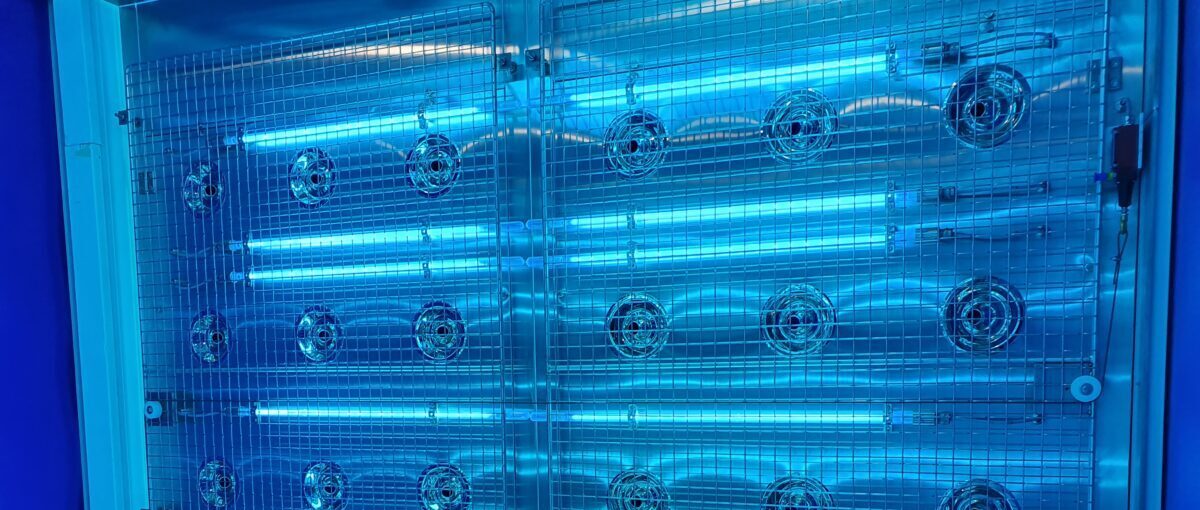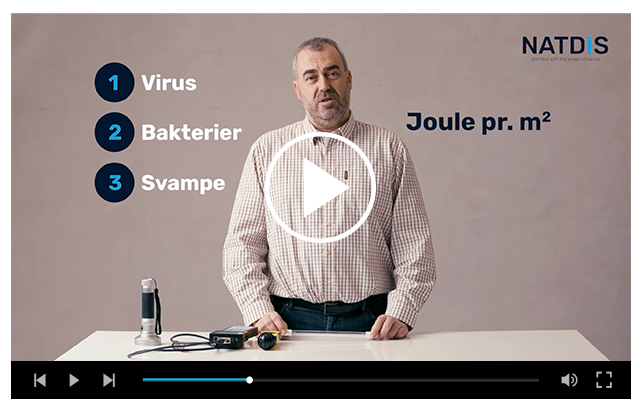How to eliminate bacterial problems with UVC light
At NATDIS, we use UVC light to eliminate bacterial problems safely and efficient. UV light is a general term for several wavelengths that cover UVA, UVB, and UVC. UVC is the part of the UV light that can be used for disinfection.
UVC light works by damaging DNA/RNA in the cell structure. When bacteria are exposed to UVC light, UVC protons destroy the hydrogen bonds in the DNA/RNA. It prevents the cell from reproducing and it will be inactivated and die.
UVC light can be used to remove bacteria in air, liquids, and on surfaces. We have different equipment for different purposes, which ensures that we eliminate bacteria efficiently.
Read more about how UVC light work here.
Why is it a good idea to eliminate bacteria with UVC light?
One of the great advantages of using UVC light to eliminate bacteria is that we get an efficient disinfection without the use of chemicals. Most disinfectants contain chemicals that harm nature and the environment, here UVC light is an exception.
Another great advantage of UVC light is that it does not require any aftertreatment. We dont have to ventilate the room that is necessary if we clean a room with harsh chemicals. Unlike chemical disinfectants, UVC light is only active when the lamp is lit and it is safe to use the room immediately after the lamp is switched off.
Read more about disinfection with UV light here.
How much UVC light is needed to eliminate bacterial problems?
When we want to kill bacteria with UVC light, we must find the right dose. We always specify a dose in joules per m² (J/m²), even the lamp itself emits light measured in watts.
In practice, this means that a 100 watt UVC lamp emits only 40 watts of UVC light. This should be considered when choosing dose.
At the same time, it is important to know the organism you want to kill. There is a big difference in how much UVC light is needed for different organisms.
Let us use E. coli as an example. Here we need about 30 J/m² to kill 90% of the given population of E. coli. This means that if we have 100 E. coli and expose them to 30 joules of UVC light, 90 of them will die.
If we compare this to Salmonella, it is harder to kill, and we need a higher dose, which is 40 J/m².
The most important thing when we want to eliminate bacteria with UVC light is that the light can reach the organism. If a bacteria is hidden form the light, it can avoid exposure and survive. We have a wide range of equipment that is suitable for different purposes in order to ensure 360° removal of bacteria.
Read more about how we remove virus with UVC light here.
Can we kill all bacteria?
When we eliminate bacteria, we can kill 90%, 99%, or 99,9%. Never 100%. No hygiene product can eliminate bacteria 100%. There will always be a bacteria that survives.
One may wonder why we do not consistently choose to kill 99,9% every time – rather than 90%. We must keep in mind that it takes a lot more energy to kill 99,9% that 90%.
For example, let us say that if we kill 90% of a given bacteria by 30 J/m², then I need 60 J/m² to kill 99% and 120 J/m² to kill 99,9%.
It is a matter of finding the right level, which ensures a high level of hygiene for the individual company. We are of course happy to help with that.
We base our recommendations for the degree of disinfection on a broad, scientific research in validated studies together with the knowledge we have from the long series of validations in which we have been involved.
Which companies need to inactivate bacteria?
Harmful bacteria are obviously undesirable in all companies, but in some industries, it is essential that they are removed. This is especially in industries that are involved in sensitive production that depends on a high level of hygiene.
Removal of bacterial problems using UVC light is particularly relevant for the following industries:
- Food production
- Pharma
- Agriculture
- Kitchen
- Hospital
- Laboratory
- Warehouse
We tailor a solution specific to your needs
Do you want to ensure a production with a high level of hygiene? Do not hesitate to contact us. Call us on +45 22 680 680 or write us to here.
At NATDIS, we deliver solutions that are made exactly to your needs and your reality. We have a solid experience with many different companies and therefore we know what questions to ask, to ensure we talk about the things that are important in your process.
We are always ready to create a NATDIS solution using UVC light to exactly your needs and demands.

